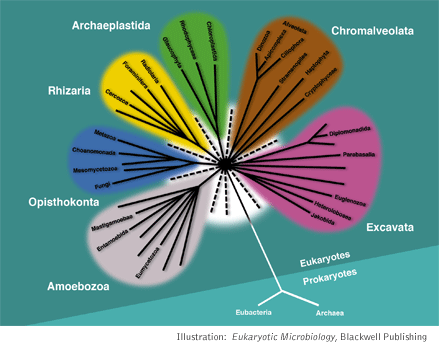


Flower Power
by CJV

![]()
Putting Organisms in Their Places
![]()
For geneticists, it’s all about speed. To effectively observe and analyze genetic traits they need a subject that matures quickly and reproduces early and often. Therefore, complex organisms like humans are not really an option.
That’s why researchers tend to use model organisms — creatures that are speedy enough and convenient for laboratory work yet representative of a large and possibly more complicated group. But how do scientists know what kind of creature in particular may represent any given group?.
Mark Farmer, a cellular biologist at the University of Georgia, thinks his research team has come up with a key to the problem. “To some extent, we’ve abandoned the Linnaean system of classification [which uses the traditional groupings of kingdom, phylum, order, family, genus and species],” he said. “We just looked at groups within groups within groups without trying to give them specific names.”

Cellular biologist Mark Farmer and his research team have devised a new way to group similar organisms. Those located on the same “petal” in the flower-shaped system not only share important similarities but also differ most significantly from those on the opposite petal. Such groupings may provide new paths to developing medical therapies.
The result is a flower-shaped pattern that radiates around a center symbolizing the ancestor cell (as yet undiscovered) that ultimately spawned all living things. The “flower” has six “petals,” and the “veins” within these petals represent smaller and smaller groups of organisms. The distance between any two petals indicates the degree to which organisms in one grouping share attributes with those in another.
For example, yeasts, roundworms and humans are all in the same Opisthokonta grouping, so findings about yeasts and roundworms may turn out to be relevant to humans as well.
“The converse is also important,” Farmer said. “Within the Opisthokonta grouping [blue petal] you have humans, and way over in the pink petal, Excavata, are the organisms that I study — euglenoids — and also the parasites that cause Chagas disease and African sleeping sickness.” Because the two petals are nearly opposite each other, whatever affects euglenoids is more likely to also affect the deadly parasites while not harming their human hosts.
“When groups have very different evolutionary histories,” Farmer said, “you can home in on unique aspects of their biology that might be good targets for medicines.”
Farmer’s classification system is a “bigger-picture result” of his and others’ microscopic work, he said. “Data from taxonomic research helped join the smaller branches — the veins in the petals — into larger groups. So a simple cell — from an alga, say — can provide useful insights into an entire group of organisms that the researcher did not expect to learn about.”
For comments or for information please e-mail: rcomm@uga.edu
To contact the webmaster please email: ovprweb@uga.edu
![]()